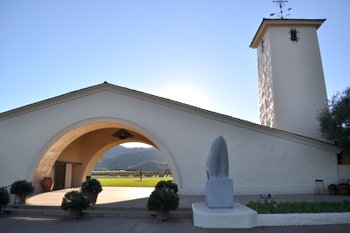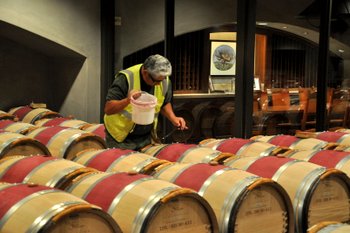
Robert Mondavi is one of the most recognizable names in Napa because the Mondavi family were pioneers in Napa valley wines. The Robert Mondavi Winery was founded in 1966 with the goal of producing wines in Napa that could rival anything produced in Europe. The wine culture at the time was small, but Mondavi persevered, along with other small and dedicated winemakers, until the the Napa Valley became the best known producer of wine in the United States. Mr. Mondavi passed away a few years ago, but he never stopped being passionate about wine and what he did. If you visit the Robert Mondavi Winery when you’re in Napa, you will definitely get a sense of the vision and drive that he had because many of the employees have been there for years and have personal stories about Mondavi that they are more than happy to share.
The California Mission-style arch that marks the entrance to the winery is iconic – and you will instantly recognize it when you see it in person because it appears on the labels of many bottles of Mondavi wine. You will have a few options when you visit, from a simple tasting to a full tour of the facility. I would highly recommend taking the tour, because Mondavi has some impressive and really state-of-the-art facilities that visitors can take a peek at and that you won’t be able to see many other places in Napa.

I started my most recent visit off with a drive through the nearly 500 acres of vineyards in Oakville known as To Kalon that surround the winery. These vineyards were originally planted in 1868 – so there is a tremendous amount of history on this site!
Grape vines typically have a lifespan of about 25 years of peak production, give or take a few years for the soil and conditions under which they are grown. This means that the vines themselves in To Kalon haven’t been growing for 150 years, just that the land has been maintained as a vineyard for that long. One unique thing that Mondavi does with some of this acreage, however, is that they maintain a few blocks of some extremely old vines from the 1940s and 1960s and use their grapes – which yield a fairly small crop – to produce a few very limited production wines. The old vines are incredibly pretty, since they grow a little more free-form than most vines are allowed to.

You can get a general idea of how much larger and more spread out the older vines are when you compare them to this (slightly) younger vines below. The colors are mostly because my visit was in fall – in the spring and summer, all the vines would be a bright green.

Back at the winery, you can see how the wine gets from the vine to the bottle almost step-by-step. If you are willing to brave big crowds during harvest season in October, you will definitely be able to see some of the process as it happens. One room houses some impressively large oak fermentation barrels that probably hold more wine than most of us could drink in a lifetime.

My favorite stop on the tour is the barrel room. The climate-controlled room is probably the most impressive barrel room in Napa (I admit, that I haven’t seen them all, but this takes my breath away every time I see it).



On this visit, I saw a winery worker carefully topping off the barrels – which were newly filled with wine from this year’s harvest – with small amounts of wine to make sure they were full to the top. It seems like a tedious job, but it is one that must be done! At the very back of the barrel room is Mondavi’s wine library. A wine library is a place where some bottles of every vintage that a winery has produced is kept. Amongst the dust and cobwebs that have gathered over the undisturbed wine, you’ll find bottles that date back to the start of the winery (and yes, the dust and cobwebs are left in the library for effect – and to show that the wine hasn’t been disturbed).


Beyond the barrel room, you may see some wines being bottled and labeled on the premises in the bottling room before heading out to the tasting room to sample a few wines yourself. You’ll find some pretty exclusive wines in their tasting room, as well as some that you might already be familiar with, and the staff there is very helpful when it comes to giving you a hand in identifying what wines you might like.







What do you think?